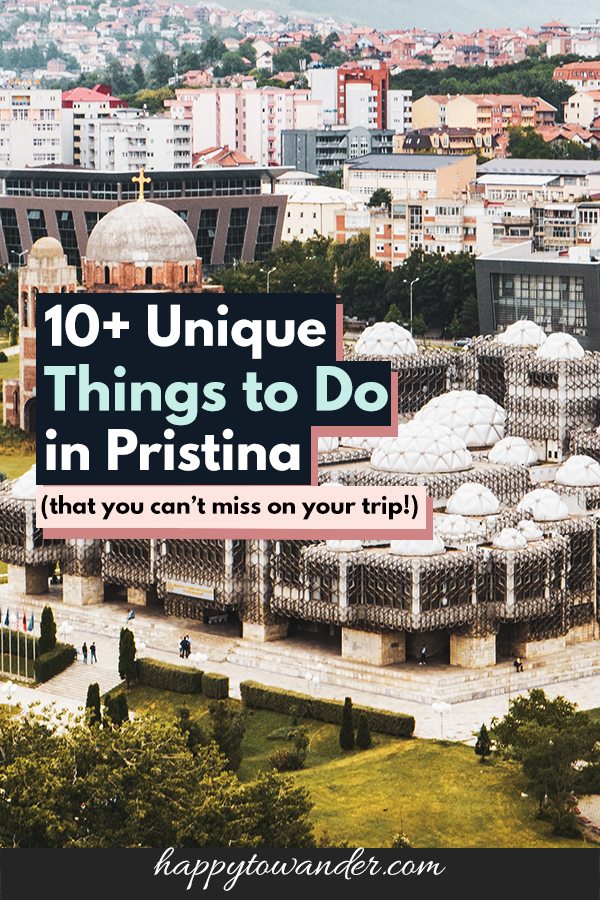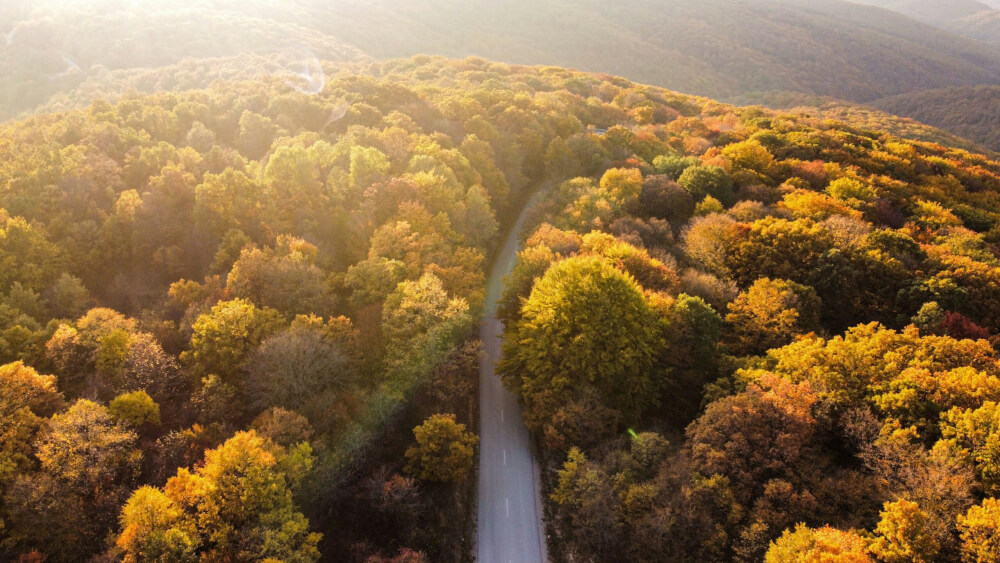*FYI - this post may contain affiliate links, which means we earn a commission at no extra cost to you if you purchase from them. Also, as an Amazon Associate I earn from qualifying purchases. Check out our Privacy Policy and Disclosure. for more info.
When it comes to European travel destinations, Pristina – the capital of Kosovo, is a city often left off of tourist itineraries.
But personally? I had a great time during my visit, and if you’re similarly drawn to more offbeat places, then I think you might like it too.
To get this out of the way, Pristina isn’t the most conventionally pretty city. If you travel mainly for picturesque aesthetics, this likely won’t be your scene. But what the city lacks in photogenic beauty, it makes up for in untapped intrigue.
In a world where we know most major sights in popular destinations thanks to social media, I found it weirdly satisfying and fun to discover Pristina from a blank slate, knowing virtually nothing about it.
As Europe’s youngest capital, there’s a unique vibe to the city that’s energetic yet relaxed, with all the pitfalls of a city (like traffic) but equally all its perks (like a vibrant cafe culture and nightlife).
Pristina can also at times feel a bit confusing – rocking old landmarks in tandem with modern restaurants and cafes, using the euro as its currency, flying American flags alongside a statue of Bill Clinton… all with beautiful calls to prayer echoing throughout the city five times a day, thanks to its Muslim-majority population.
As I said though, I really enjoyed Pristina, and if you’re similarly intrigued (or already planning for your trip), then read on for a list of Pristina must-dos!
1. Enjoy the view from the Mother Teresa Cathedral Bell Tower
While Pristina doesn’t have many actual attractions, the main one I think every tourist should visit is the Mother Teresa Cathedral.
In European cathedral terms, this one is a fresh-faced baby, having only just been officially consecrated in 2017 after a decade of construction.
So in terms of historic value, most locals would argue there is none. And there have been criticisms of building such a tall cathedral where Catholicism is such a minority religion (compared to the 95% Muslim population)… But controversies aside, while it’s not over-the-top extravagant, this cathedral does have pretty interior, and more importantly, the best view in town from its bell tower. If you want to get an overview of the city, this is the spot!
From here, you can appreciate some of Pristina’s more notable pieces of architecture (like its wildly divisive library, but more on that below).
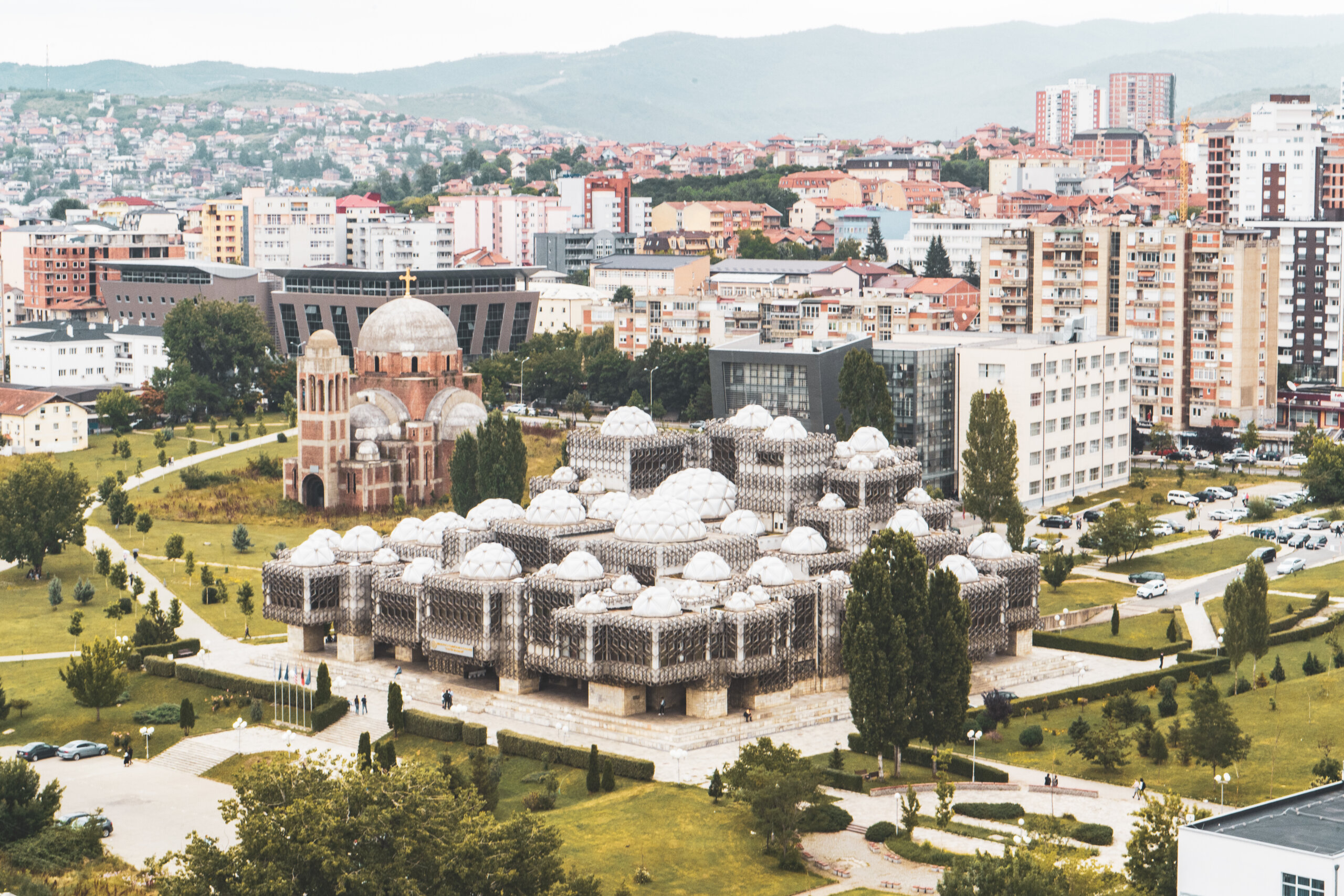
2. Visit the National Library of Kosovo
Once hailed as one of the world’s ugliest buildings, I think the National Library of Kosovo is a must-see on any visitor’s itinerary.
Love it or hate it – it’s a talking piece for sure.
Designed by Croatian architect Andrija Mutnjaković and completed in 1982, the library is a striking example of Brutalist architecture, with bold, geometric forms and the use of raw concrete. The exterior has a very unique aesthetic, featuring a grid of 99 domes of varying sizes and a façade covered in a distinctive metal net.
This design was intended to symbolize the merging of Albanian and Serbian cultures through Byzantine and Islamic architectural elements – although opinions on the result differ wildly! Many locals and visitors alike have debated its appearance, with some praising it as a masterpiece of modernist architecture while others deride it as an eyesore.
You should definitely check it out for yourself and make up your own mind while visiting Pristina…
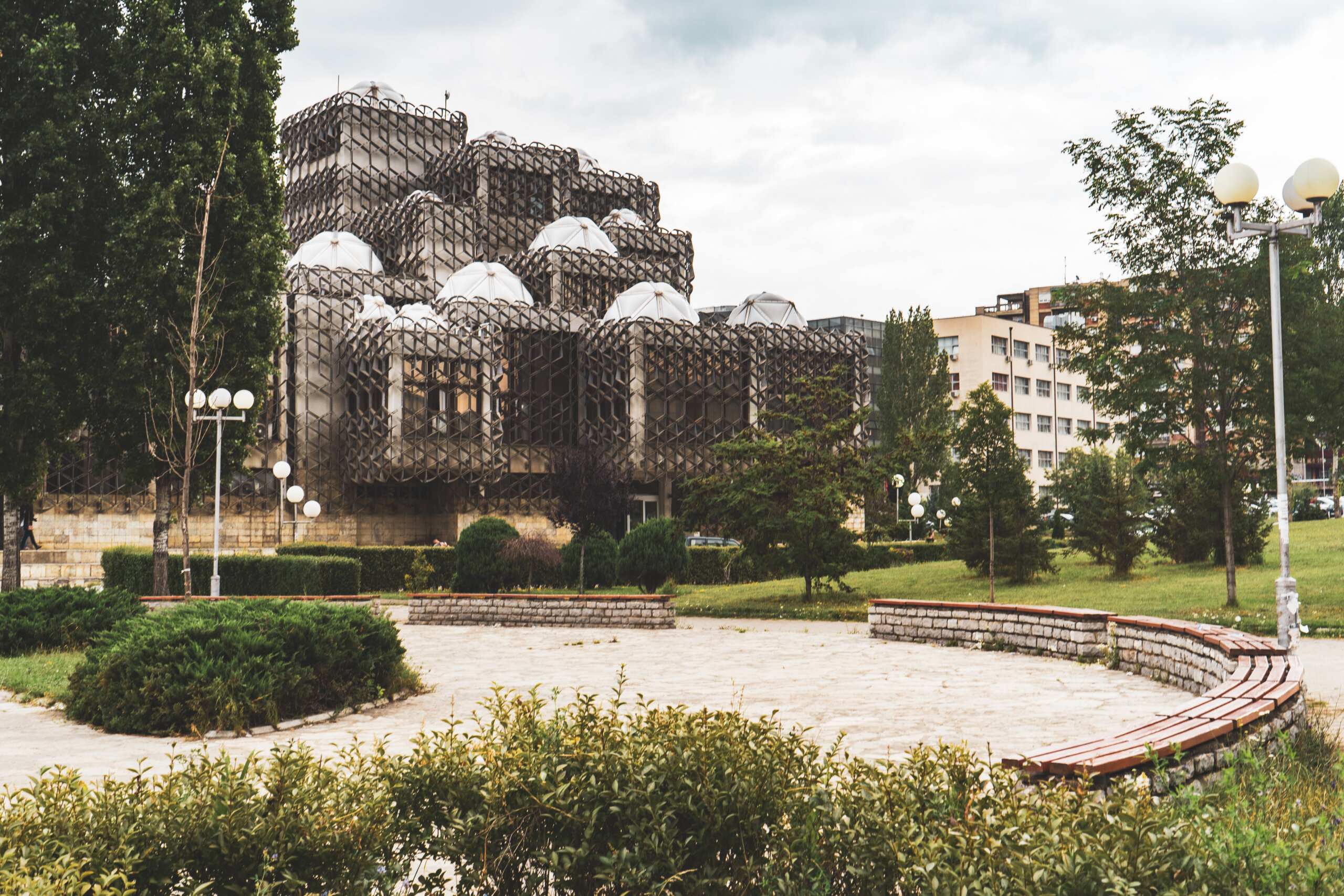
The inside is free to visit and quite cool to see as well:
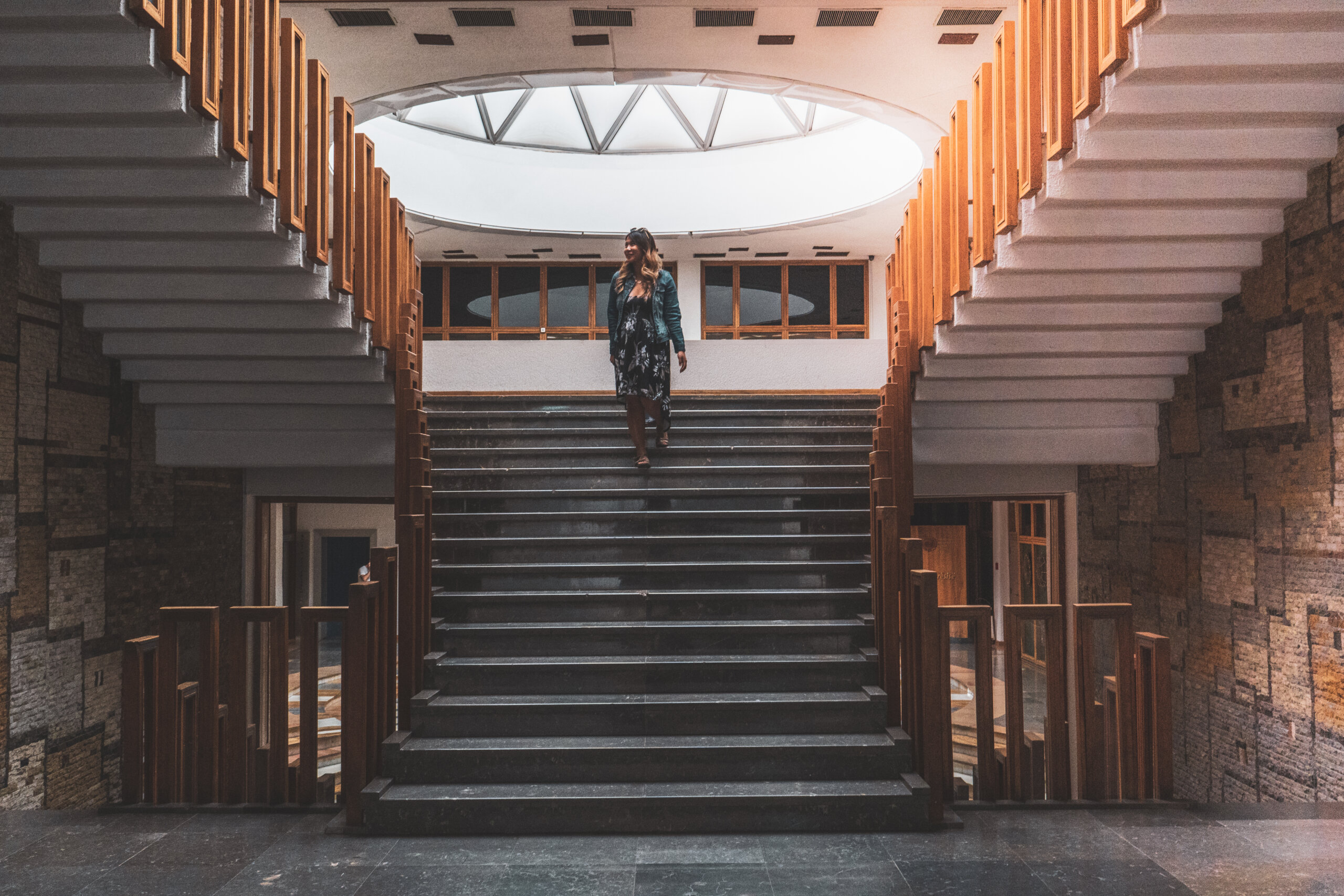
3. Stop by the National Gallery of Kosovo
Located close to the library (and far less controversial) is the National Gallery of Kosovo.
Established in 1979, the gallery is housed within the building complex of the University of Pristina, and serves as the premier institution for visual arts in Kosovo. It features a diverse range of exhibitions that include painting, sculpture, photography, and multimedia installations. The collections also display both the traditional and modern aspects of Kosovar art.
Of course, the history of the gallery is intertwined with Kosovo’s own journey towards independence and self-expression. During the turbulent 1990s, the gallery faced numerous challenges, including the loss of many artworks and resources. Today however, the National Gallery of Kosovo works to preserve and celebrate the country’s artistic heritage – making it a fascinating spot to explore when you’re in Pristina.
4. Admire the Imperial Mosque
The Imperial Mosque, also known as the Sultan Mehmet Fatih Mosque, is one of the most significant landmarks in Pristina and well worth a visit.
Built in 1461 under the orders of Sultan Mehmet II (the Ottoman ruler famously known as Mehmet the Conqueror) this mosque is an exquisite example of Ottoman architecture. It features a large central dome, flanked by smaller domes, and an elegant minaret that stands as a prominent feature of Pristina’s skyline. The interior is equally impressive, adorned with intricate Islamic calligraphy and geometric patterns.
A visit here offers a glimpse into the deep-rooted Islamic heritage of Kosovo and is also just a lovely peaceful spot to have a little wander, although it’s also an active place of worship so you may need to admire it from outside if you visit during prayer times.
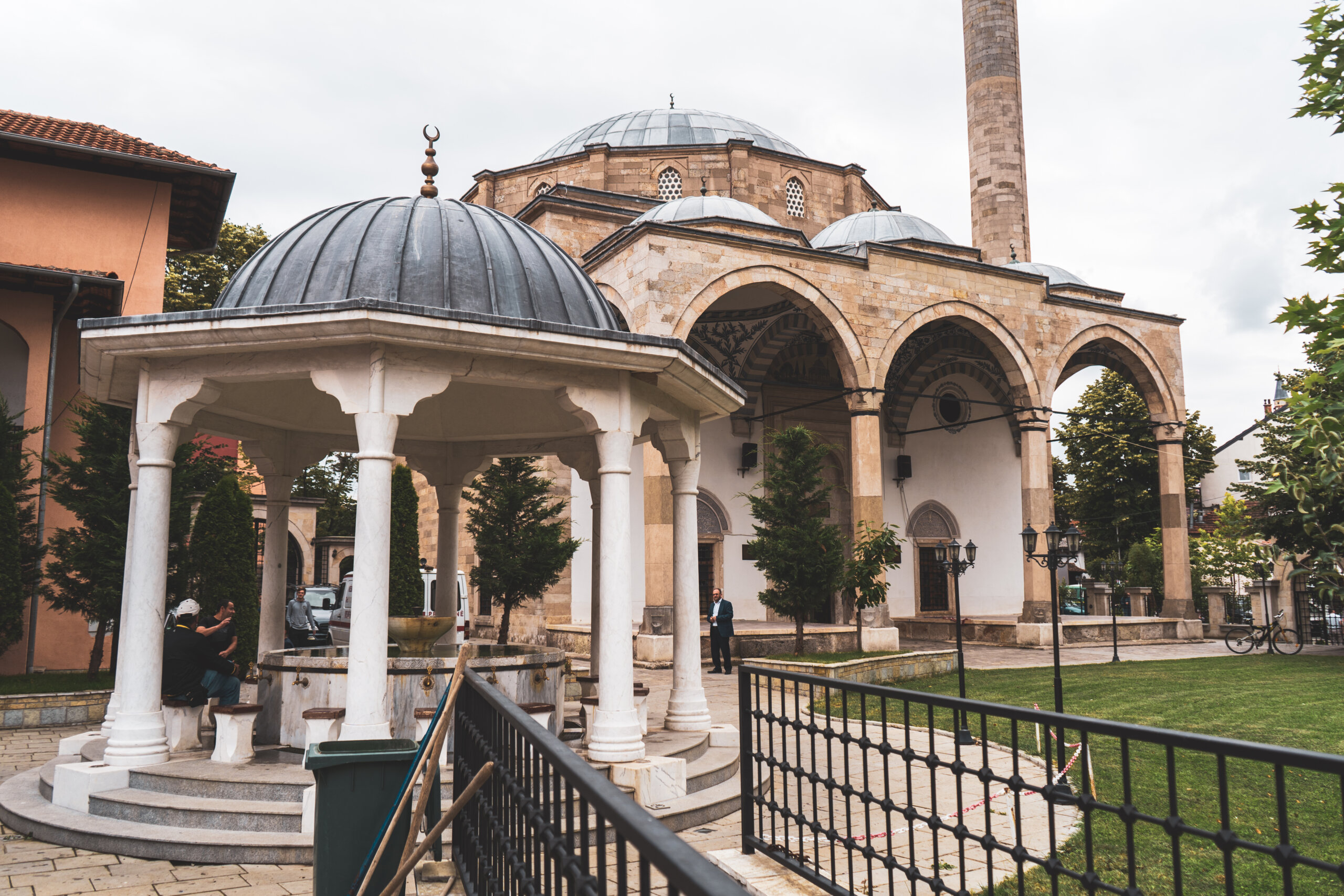
PS: While here, you’re also very close to the Pristina Clock Tower.
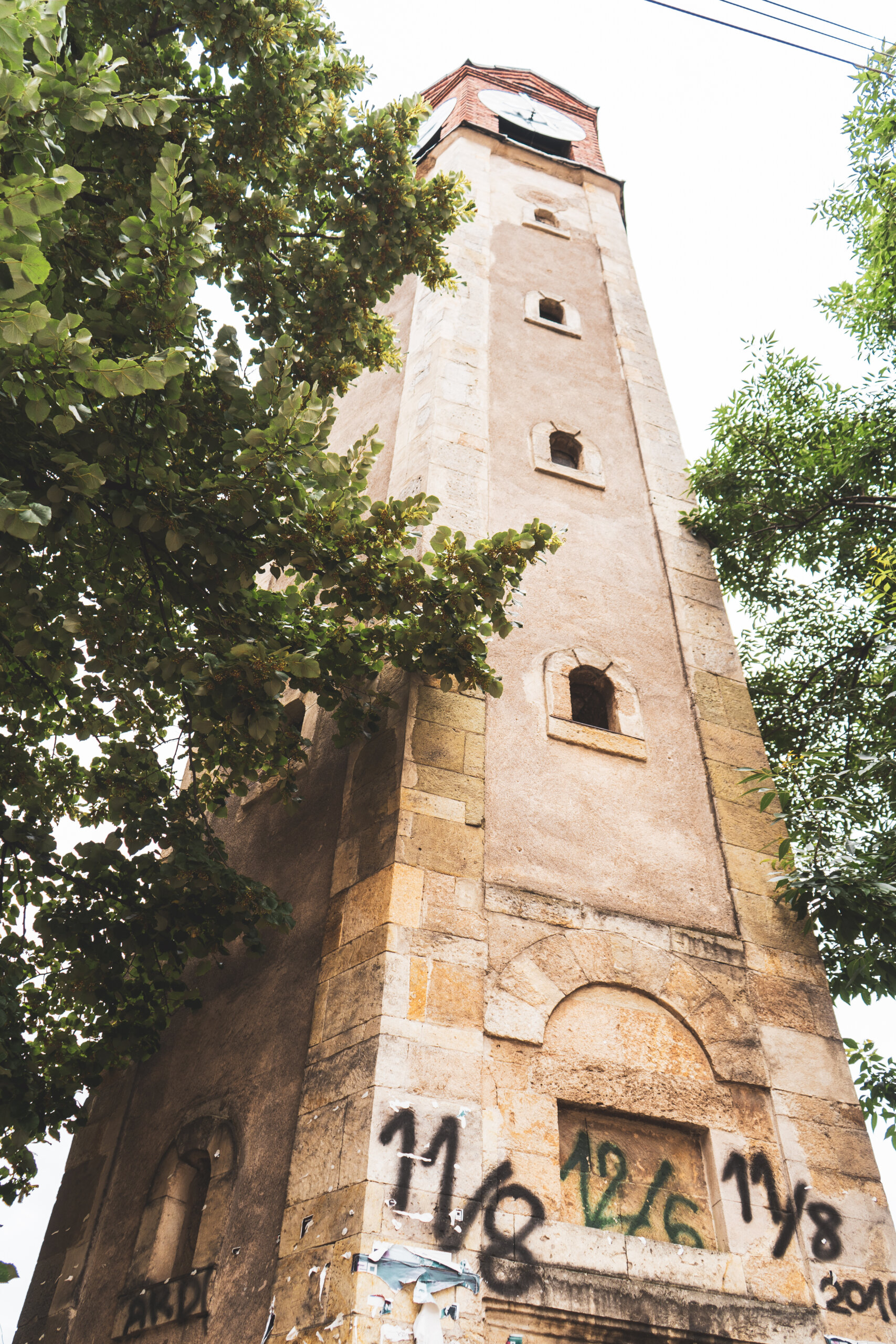
5. Wander along Mother Teresa Boulevard
This main pedestrian thoroughfare in Pristina is Bulevardi Nënë Tereza, AKA Mother Teresa Boulevard. A stroll along here is a must to get initiated with the vibe of Pristina, which combines chaotic Balkan city energy with a leafy and green calmness that I encountered pockets of throughout my visit.
Common word on the tourist circuit is that Kosovo’s quaint 2nd city, Prizren, has much more to offer than bustling Pristina… but I don’t think that’s fair to say. Pristina can be a busy mess of traffic and cigarette smoke, but there’s also lovely areas where you’ll see a much calmer side to the city… and this street is one of them.
There’s bookshops, hotels, little stalls in the boulevard selling goods, and many, many locals just enjoying their day, whether that’s kids running around playing, older folks enjoying a chat with friends on a bench, or couples strolling the boulevard hand in hand. This strip is a people watcher’s dream, and I think a visit here is a must for any tourist.

6. Stop by Pristina’s main squares
Along this boulevard, you’ll also encounter most of Pristina’s main squares…
- Mother Teresa Square: a modest square lined with cafes and restaurants, best known for the statue of Mother Teresa
- Skanderbeg Square: a wide square next to Mother Teresa Square, this one contains a large statue of the medieval Albanian hero Skanderberg on a horse
- Ibrahim Rugova Square: connected to Skanderberg Square is another one named for the main statue, this one is dedicated to a former president of Kosovo and also contains some fountains and pleasant spots to sit
I don’t necessarily think these squares will wow you as they’re quite plain, but a quick lap around them will help you get better acquainted with the city’s layout (and history too!)
7. Go café hopping
One of my favourite things about Pristina was its lively cafe culture. If you like coffee, Pristina is your place. Heavenly macchiatos for less than 2 euro apiece are abundant in every corner of the city, whether you want a beautiful aesthetic cafe experience or just a simple and homey place to caffeinate.
I really enjoyed Dit’ e Nat’ for its cozy vibe and tasty menu but I’ve also heard great things about Soma Book Station. Honestly though, we just kept popping into random cafes as caffeine cravings began to hit and we were never disappointed, so be sure to leave some room for spontaneity!
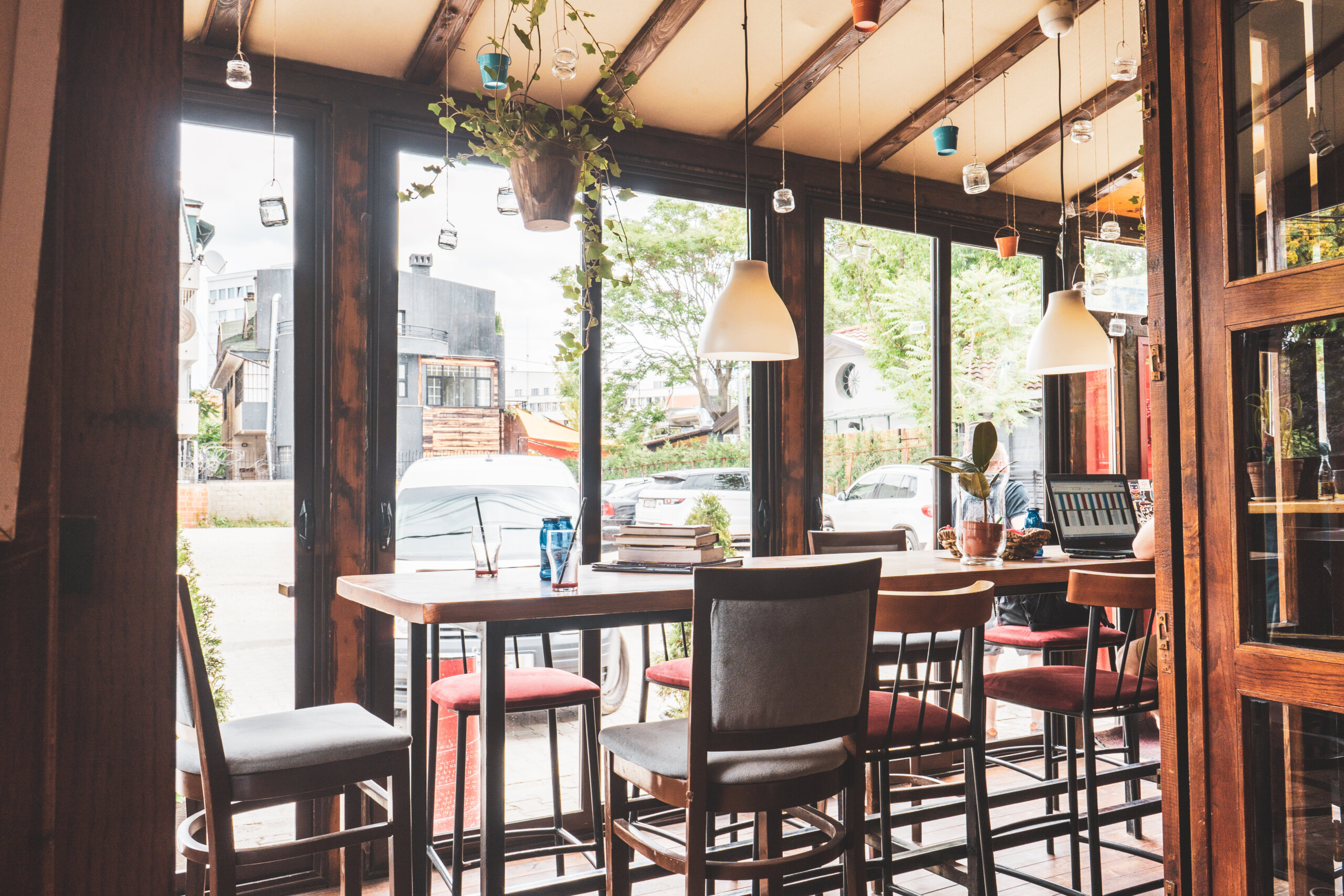
8. Admire the Newborn Monument
While not the most ornate or extravagant monument, Pristina’s Newborn Monument is a must-see for what it represents – the day that Kosovo declared itself independent from Serbia on the 17th of February 2008.
Created by the local artist Fisnik Ismaili, this 3 metre tall monument consists of large letters spelling out the word “NEWBORN”. It was initially painted bright yellow, representing hope and a fresh start… but in keeping with the “fresh start” theme, each year, it is repainted to reflect different themes or messages that are significant to the people of Kosovo. For example, in 2013 it was painted with the flags of the 111 (out of 193) United Nations member countries that recognise Kosovo as an independent state.
So don’t be surprised if when you go to look at it’s completely different from all the images you’ve seen online! It’s mainly just a photo opp but a very cool one that also has meaning beyond just looking nice. Check out this page (you need to scroll down a bit) to see the different paintings and their meanings from 2013 – 2021.
Fun Fact: the singer Rita Ora was born in Pristina and can be seen frolicking around the city in the music video for her song Shine Ya Light – including a bit where she dances on the Newborn Monument!
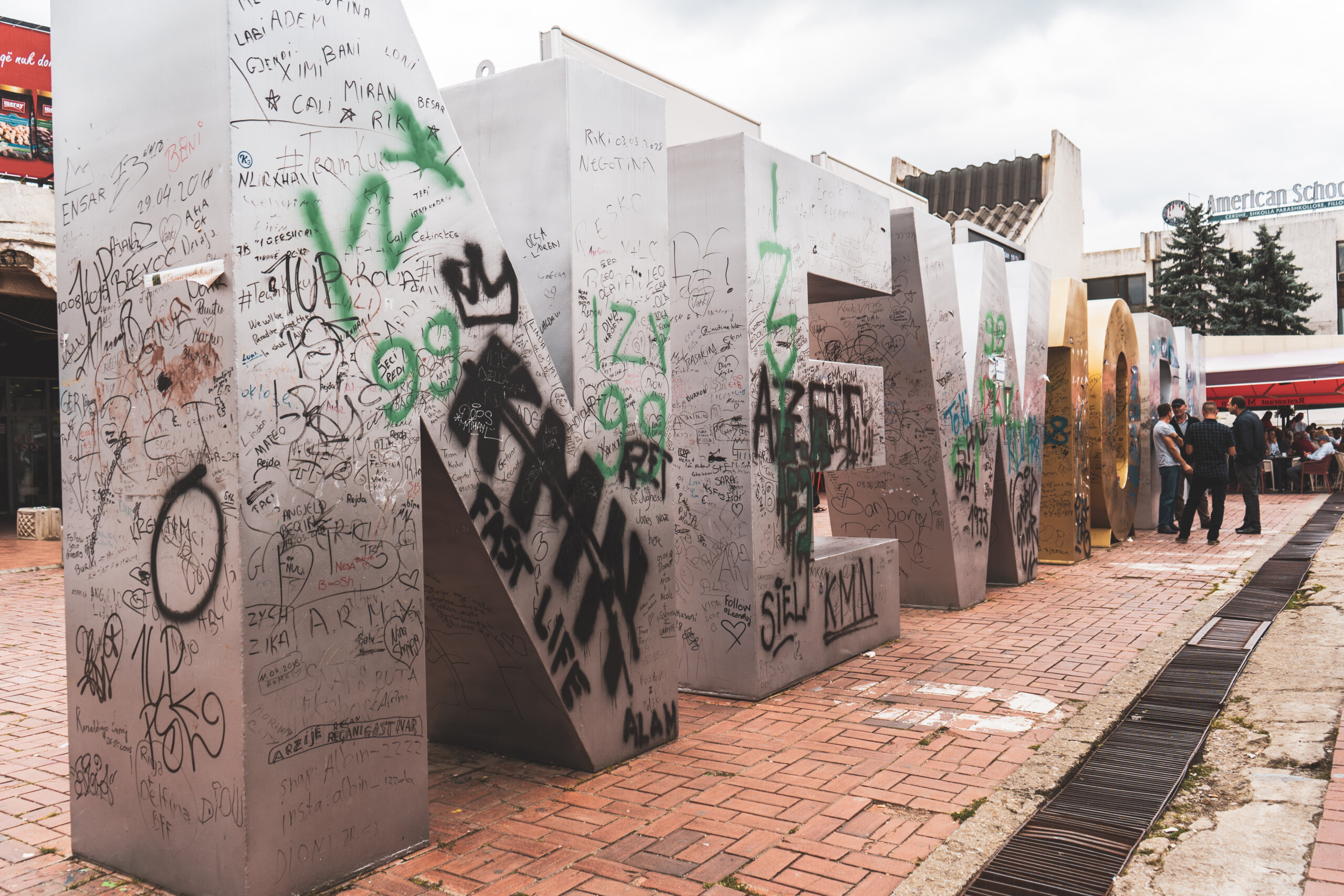
9. Say hi to the Bill Clinton statue
For a North American visiting Kosovo for the first time, it might seem weird to see a statue dedicated to Bill Clinton in the middle of a bustling Balkan city, but there’s good reason for this.
Long story short, during the late 1990s, Kosovo was embroiled in a brutal conflict marked by ethnic violence and widespread human rights abuses. As the situation deteriorated, then-US President Clinton played a pivotal role in galvanizing NATO to intervene against Serbian forces in 1999. This ultimately led to the end of the war and paved the way for Kosovo’s eventual declaration of independence in 2008.
For many Kosovars, Clinton’s actions were seen as a lifeline. In recognition of his decisive support, the Kosovar government and its citizens have honoured him in various ways, including naming major streets and erecting statues in his likeness, particularly this three-meter-tall statue in the capital city.
These days, this spot is mainly just a photo opp, but it’s an interesting Pristina landmark to take note of.
PS: No word of a lie, there’s a shop close to here called ‘HILLARY’ that sells pantsuits. Which Hillary Clinton herself has indeed visited. Do with that information what you will.
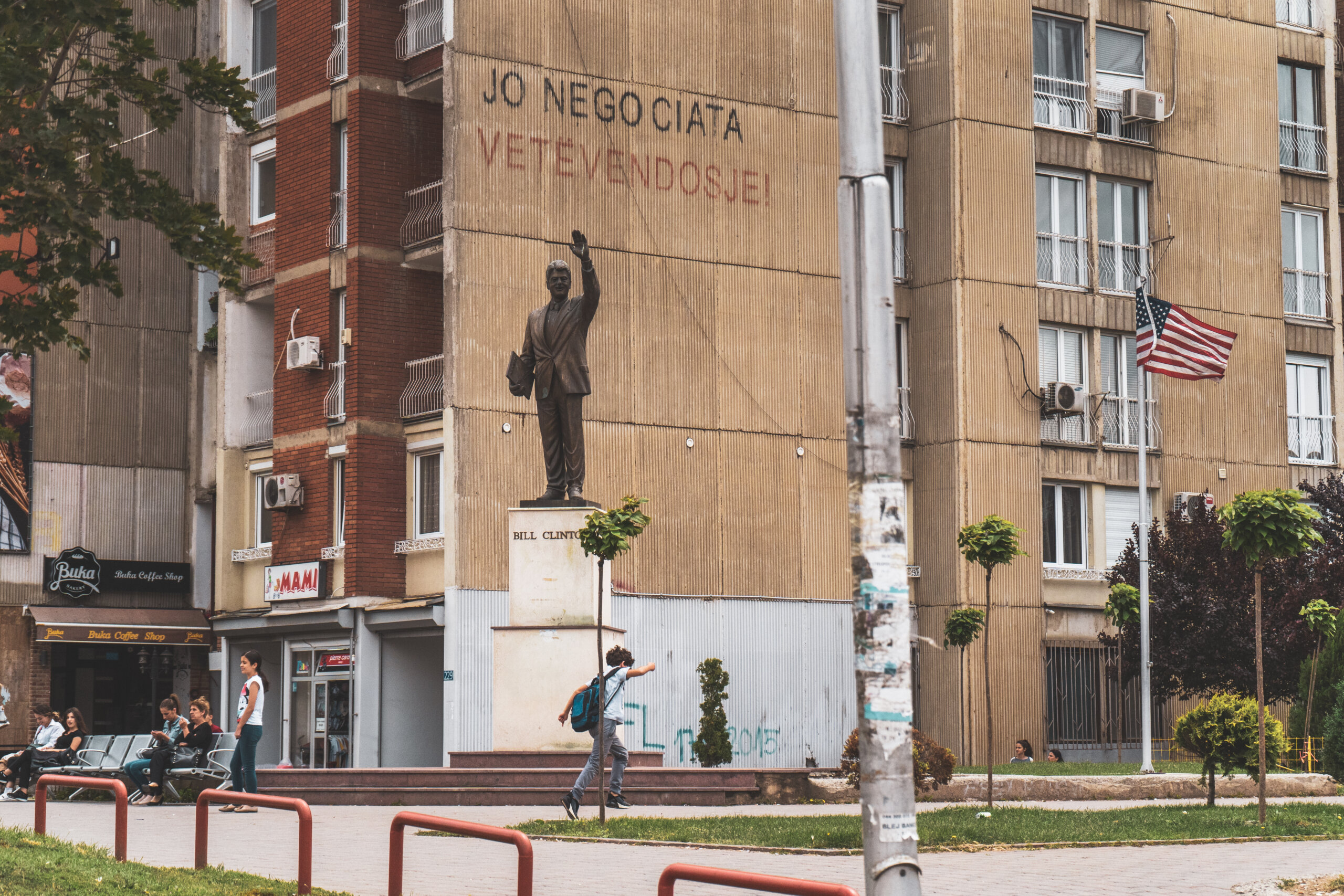
10. Visit the Ethnographic Museum
For those interested in more Pristina activities that explore the rich history and culture of Kosovo, including traditional clothing and artifacts, then a visit to the Ethnographic Museum is a must-do in Pristina.
This museum is housed in a beautiful traditional Ottoman-era building, the former home of the family of Emin Gjikolli, which itself is quite an attraction. The architecture is stunning, with old wooden beams, stonework, and traditional layout, giving you a real feel for how locals lived in the past. Inside, there’s an impressive collection of items that showcase the daily life, customs, and traditions of the Kosovar people.
One of the highlights is the traditional room setups, where you can see how typical Kosovar homes were furnished, complete with beautiful rugs, cushions, and handcrafted items. It’s the ideal destination if you’re curious about how people lived in Kosovo in the past.
11. Kosovo Museum
Another interesting museum to visit in Pristina if you want to learn more about Kosovo’s history is the National Museum of Kosovo. This museum is actually the oldest in Kosovo, established in 1949 by Yugoslav authorities.
The building itself was constructed in the late 19th century and initially served as the Austro-Hungarian army’s headquarters. The Ethnographic Museum is also technically part of the Kosovo Museum, but housed in a separate building. You can’t miss the Kosovo Museum though, as the building is yellow with a grand staircase at the entry.
Inside you’ll find exhibits that look at the ancient history of the region with archaeological artifacts, pottery, and even some impressive Roman statues. The museum also touches on more recent history, including the struggles and conflicts that have shaped modern Kosovo.
It’s a relatively small museum but it’s also free to visit so if you’re looking for something to do on a rainy day or just like learning about history, check it out!
12. Great Hammam
The Great Hammam is an Ottoman-era building that makes for another unique sightseeing opportunity in Pristina.
It’s believed that this traditional Ottoman bathhouse was built in the mid-15th century, around the same time as the city’s Imperial Mosque and that it was part of the mosque complex as it’s located just around the corner. The building itself is quite striking, with a series of domes and beautiful stonework. The domes were designed with small openings, called “oculi,” to let in natural light and steam.
The layout of the hammam included separate sections for men and women, with each area having its own series of rooms, like the cold, warm, and hot rooms, as well as a massage area. Although the Great Hammam is no longer in use as a bathhouse, it is being preserved with plans to convert it into the Museum of Pristina.
For now you can only check it out from the exterior, but keep an ear out for when the restoration/museum plans might be finished!
13. Admire street art
One of the greatest surprises of my Pristina visit was the abundance of cool street art all around the city.
Maybe I was just delighted by the contrast, but I loved seeing colourful murals and graffiti adding a splash of colour to the otherwise neutral tones of Pristina’s grey and beige palette.
You’ll honestly encounter many of these murals just walking around, but some spots especially known for it include…
- Rruga B: During the 2023 Meeting of Styles graffiti art festival this long street was taken over by more than 100 artists from around the world to revitalize the slabs of concrete with murals.
- Near the train station: The 2024 Meeting of Styles festival took place near the train station in the neighbourhood of Arbëria, with even more vibrant art works than the previous year!
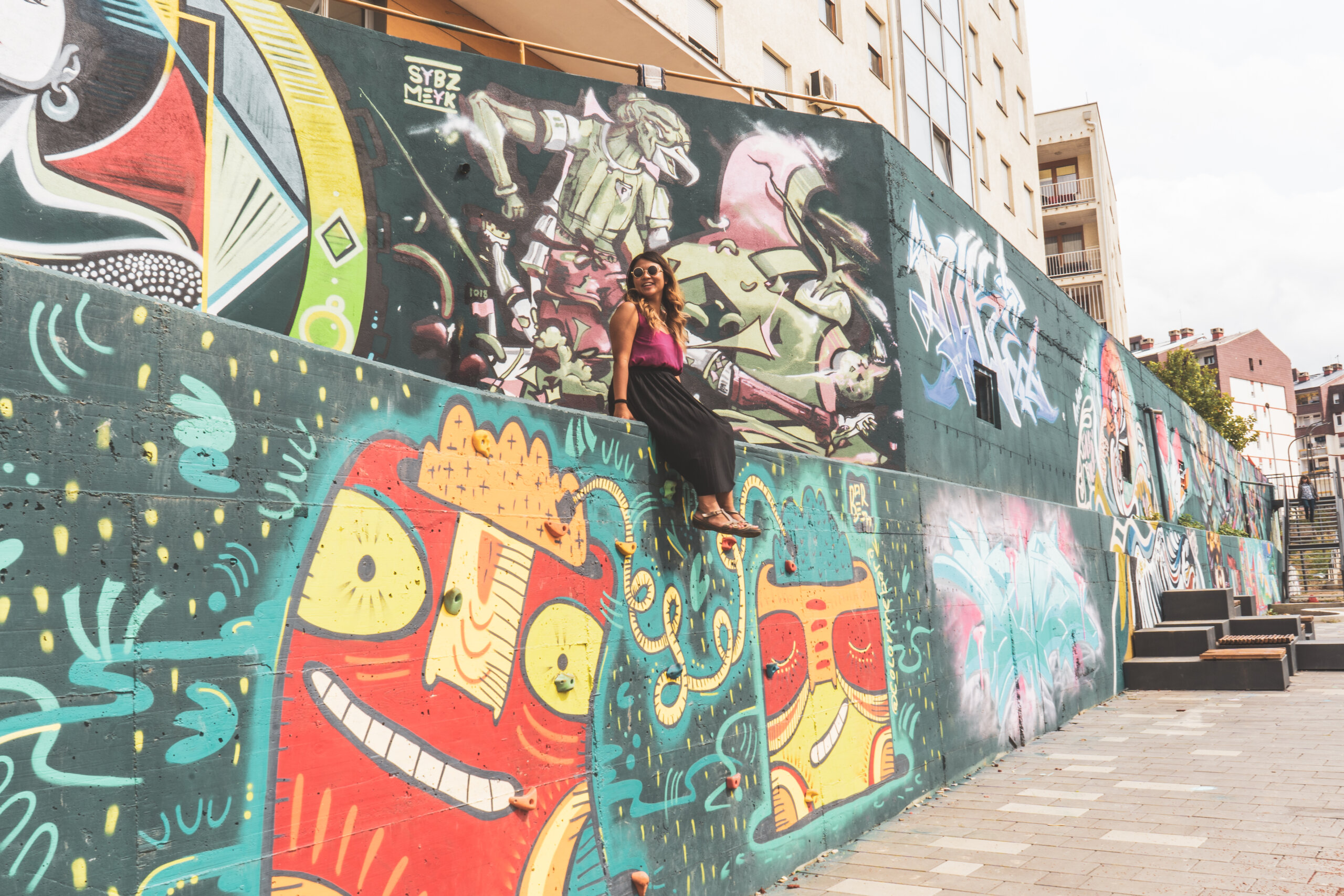
14. Amble around the Bazaar of Pristina
Also known as the Green Market Prishtinë, I wouldn’t say Pristina’s Bazaar is a must-see on its own, with it being a small market selling mainly fresh produce and a handful of household items.
But, if you’re nosy and want to get a little glimpse into local life, it’s a nice little stop. Just don’t expect a grand bazaar that you can get lost in – you could probably walk through the whole thing in less than 15 minutes.
15. Climb the Dragodan Steps
For panoramic views of Pristina, another fun option is climbing the Dragodan Steps.
Marked as Shkallët e Dragodanit on Google maps, these stairs rise 450 metres through the neighbourhood of Arbëria – which used to be called Dragodan, meaning “good day” in Serbo-Croatian. This area is where many diplomats or people working at embassies in Pristina live, so it’s a bit of a chance to ogle one of the more affluent parts of the city, as well as seeing the views from the ridgeline.
In 2021 the entire staircase was also painted, but I’m not 100% sure if that artwork remains! Either way, a walk up the 258 steps is a great way to have a look out over Pristina, especially if you like getting in a good workout on your travels…
16. Explore Gërmia Park
And for those interested in seeing a more natural side of Pristina, be sure to stop by Gërmia Park, a green oasis offering hiking trails, pools, and picnic spots, perfect for unwinding.
Covering an area of about 62 square kilometres on the outskirts of the city, this park is filled with trails for hiking, running or mountain biking, along with places to go camping, an outdoor swimming pool, tennis courts, basketball courts and children’s playgrounds.
Basically, anything you might want to do outside on a nice day, you can probably do here! In winter there are even ski lifts so you can hit the slopes while there are regular events and festivals throughout the year, particularly in summer.
There’s a road through the main park area so you can drive to it, along with a couple of different cafés and restaurants. If you don’t have a car there’s also a bus stop right at the beginning of the park, next to a handy bike rental kiosk.
17. Day trip out to Gračanica Monastery
Finally, a day trip to Gračanica Monastery is a fantastic addition to any visit to Pristina, offering a serene escape from the city after a short 30-minute drive.
This stunning Serbian Orthodox monastery is a UNESCO World Heritage site, celebrated for its exquisite medieval architecture. Built in the early 14th century by King Stefan Milutin, the monastery is one of the finest examples of Byzantine architecture in the region, blending Romanesque and Gothic elements.
It features an iconic five-domed structure and once inside visitors can marvel at the beautiful old frescoes that adorn the walls, depicting scenes from the life of Christ, the Virgin Mary, and various saints.
Do be aware that photography inside the monastery is not permitted and visitors should dress respectably – including headscarves for women.
Did I miss any of your favourite things to do in Pristina?
Let me know in the comments so I can add more of the best Pristina activities to the list. Happy and safe travels! 🙂

